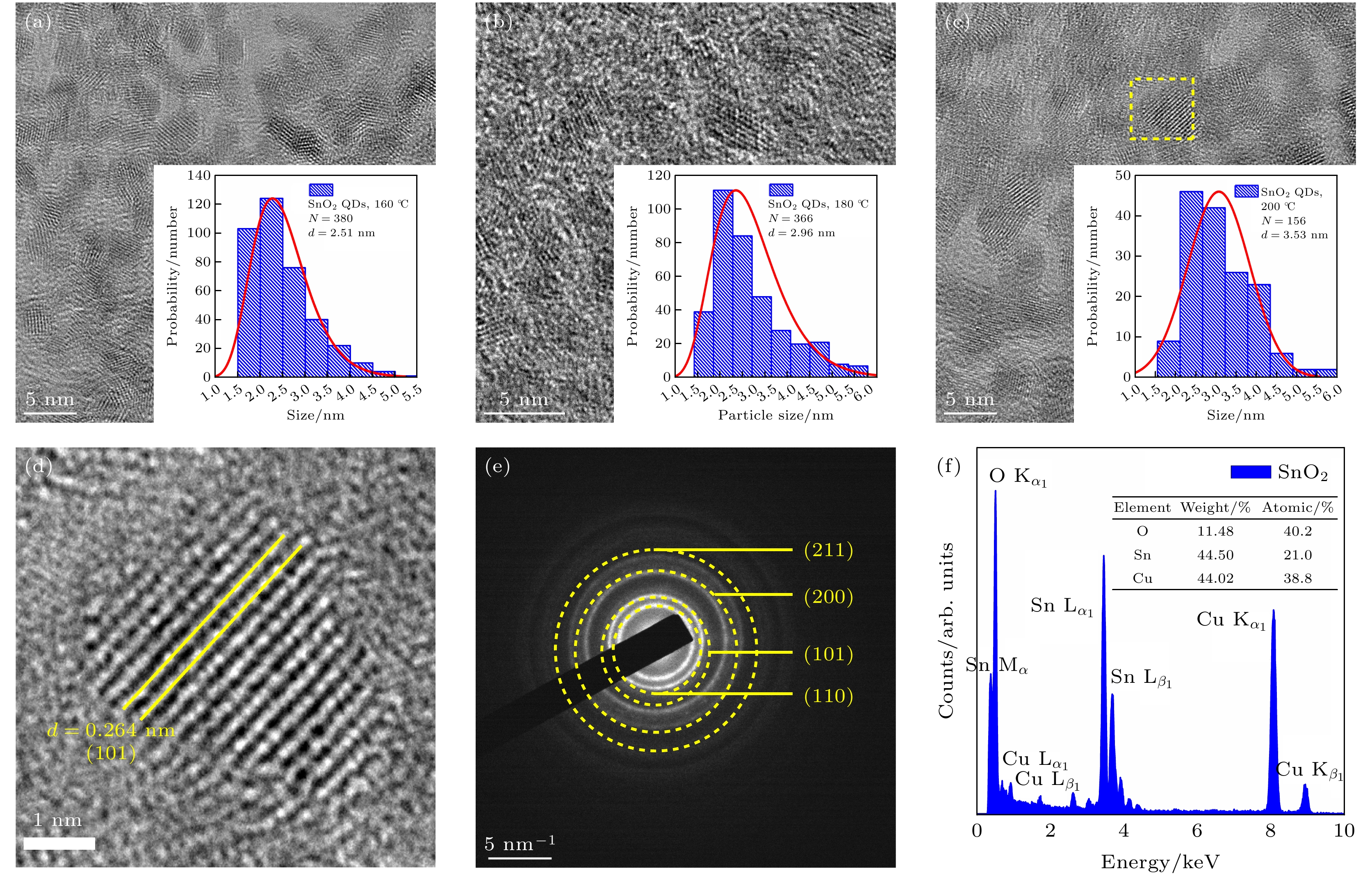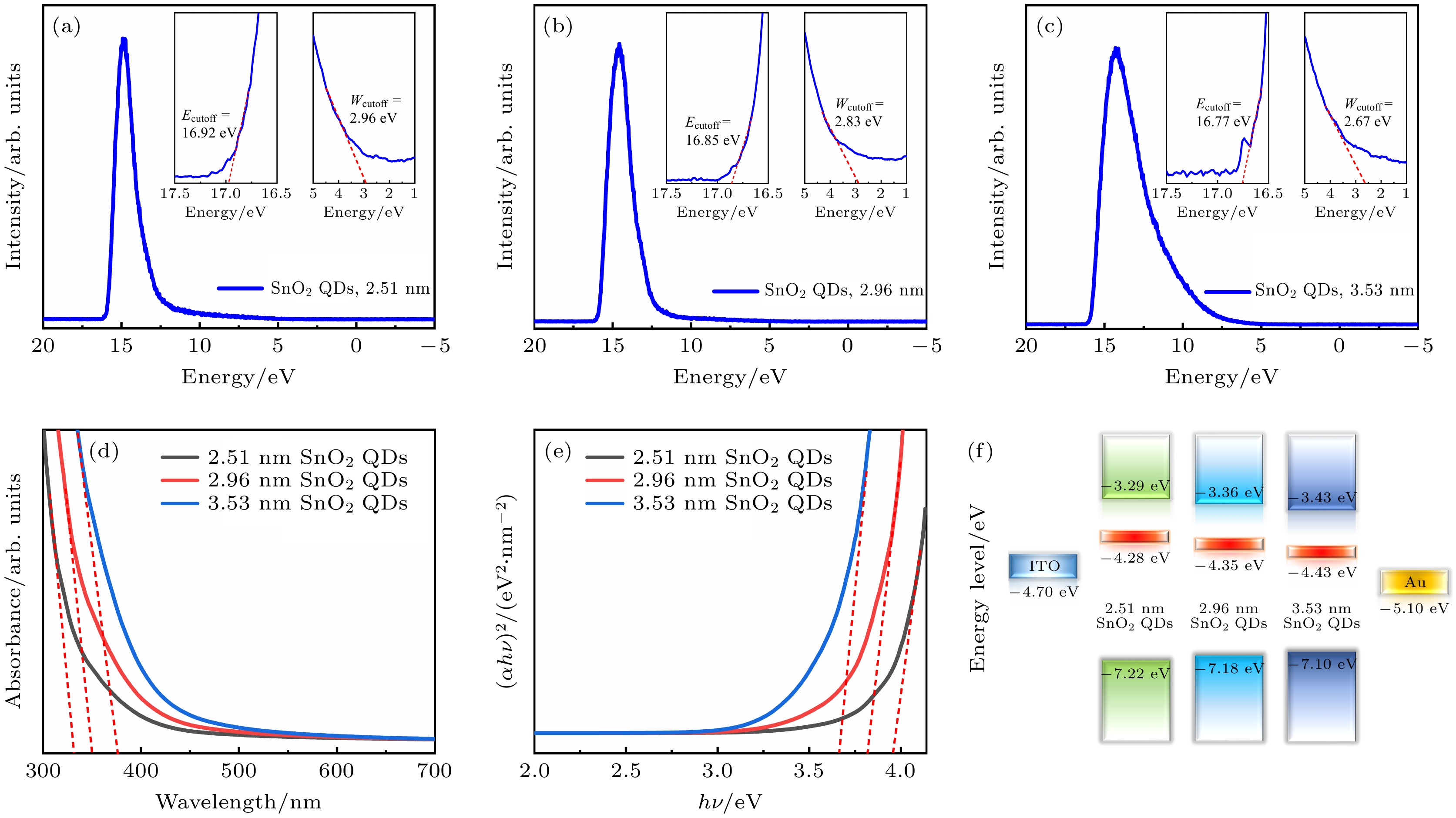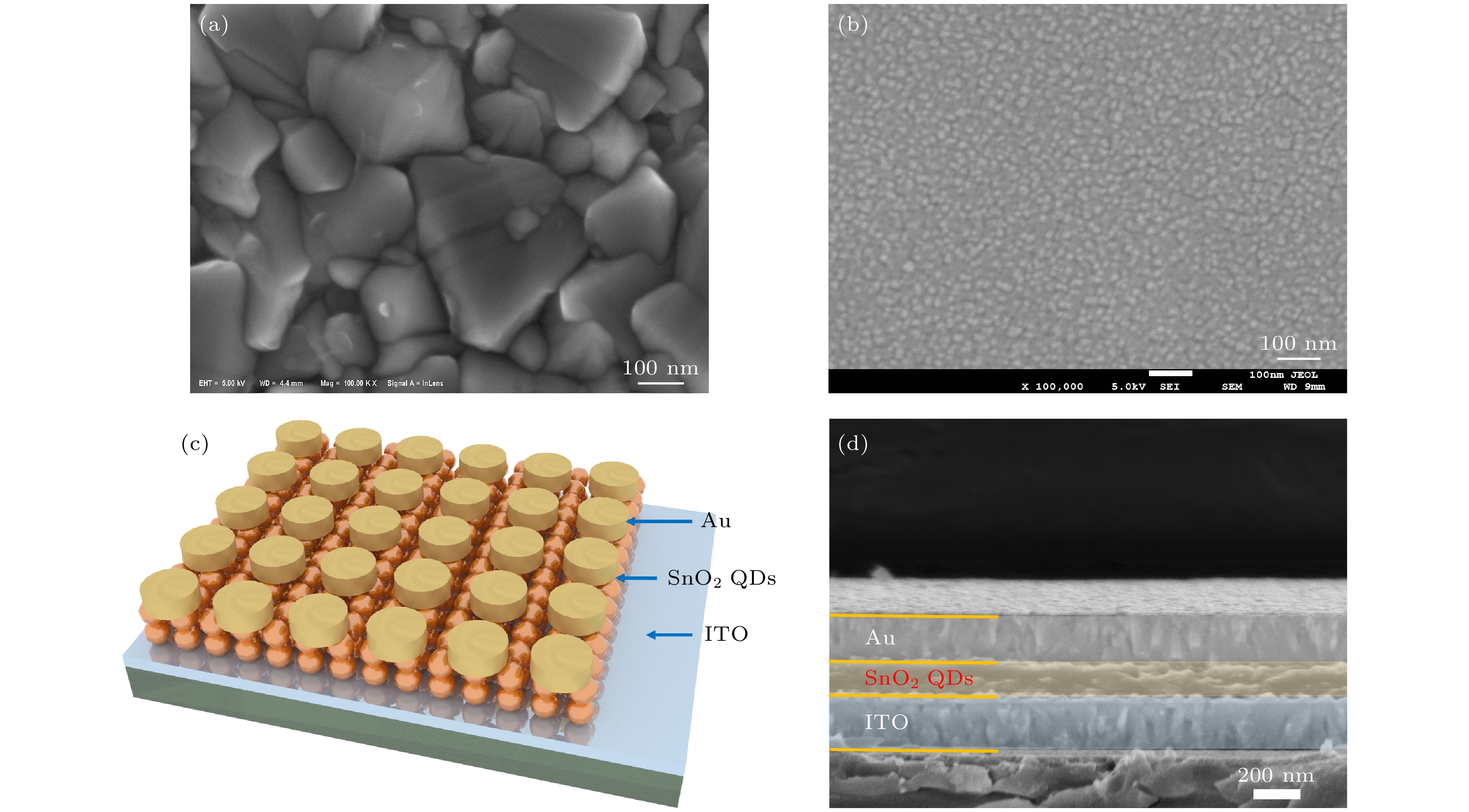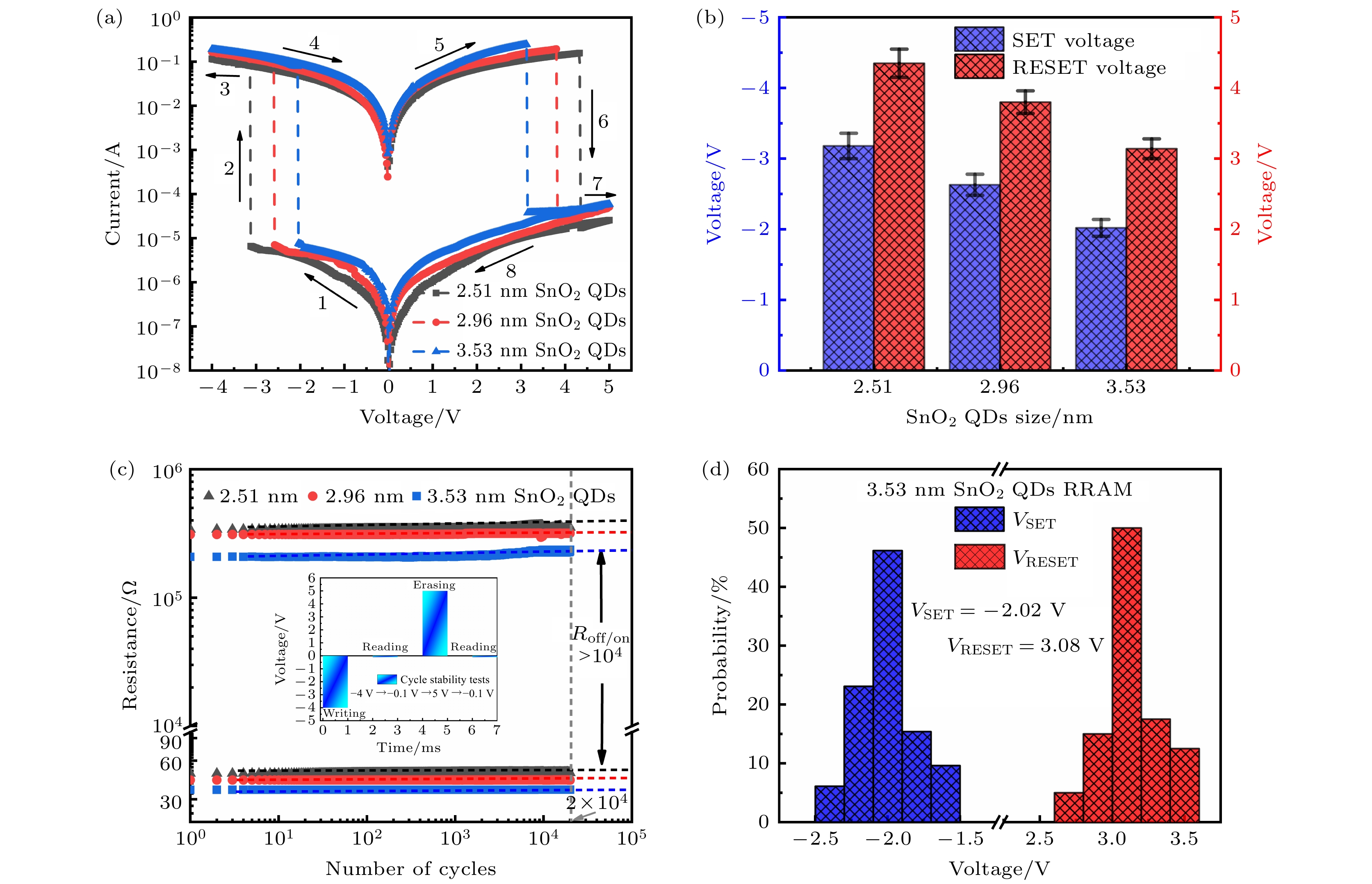-
零维SnO2量子点因具有优异的物理化学稳定性、高电子迁移率和能带结构可调等特性, 是阻变存储器中阻变功能材料的良好选择, 受到了研究者的广泛关注. 本文采用溶剂热法制备了尺寸为2.51 nm, 2.96 nm和3.53 nm的SnO2量子点, 在较小尺寸范围内证明了SnO2量子点能带结构随尺寸离散化的量子尺寸效应; 并基于其量子尺寸效应, 实现了对SnO2量子点阻变存储器开关电压的有效调控. 研究表明, 尺寸为3.53 nm的SnO2量子点具有较低的开关电压(–2.02 V/3.08 V)与较大的阻变开关比(> 104), 器件在经过2 × 104次的耐久性测试后, 阻变性能变化率小于5%, 具有较好的稳定性与保持性. 基于库仑阻塞效应, SnO2量子点内部缺陷势阱作为俘获中心对电子的自俘获/脱俘作用, 是其实现阻变效应的原因; 此外, SnO2量子点与ITO, Au界面肖特基势垒高度的有效控制则是精准调控其阻变开关电压的关键. 以上工作揭示了SnO2量子点在阻变存储领域的巨大应用潜力和商业化应用价值, 为阻变存储器的发展提供了一项新的选择.As a non-volatile memory, zero-dimensional quantum dot resistive random access memory (RRAM) has shown broad application prospects in the field of intelligent electronic devices due to its advantages of simple structure, low switching voltage, fast response speed, high storage density, and low power consumption. Tin dioxide quantum dots (SnO2 QDs) are a good option for resistive functional materials with excellent physical and chemical stabilities, high electron mobilities, and adjustable energy band structures. In this paper, the SnO2 QDs with sizes of 2.51 nm, 2.96 nm and 3.53 nm are prepared by the solvothermal method, and the quantum size effect is observed in a small size range and the effective regulation of resistive switching voltage is achieved based on its quantum size effect, which is the unique advantage of quantum dot material in comparison with that of bulk material. Research result shows that as the size of SnO2 QD increases, the SET/RESET voltage gradually decreases from –3.18 V/4.35 V to –2.02 V/3.08 V. The 3.53 nm SnO2 QDs have lower SET/RESET voltage (–2.02 V/3.08 V) and larger resistive switching ratio (> 104), and the resistive switching performance of the device has changed less than 5% after having experienced durability tests 2 × 104 times, showing good stability and retention. Besides, according to the fitting of charge transport mechanism, SnO2 QD RRAM exhibits Ohmic conduction under LRS, while Ohmic conduction, thermionic emission and space charge limit current work together during HRS. The resistive switching effect of SnO2 QDs is controlled by trap filled limit current and interface Schottky Barrier modulation; the trapping/de-trapping behavior of internal defect potential well of SnO2 QDs on electrons dominates the HRS/LRS switching, while the effective control of ITO/SnO2 QDs and SnO2 QDs/Au interface Schottky barrier is the key to accurately regulating the switching voltage. The reason why SnO2 QD RRAM exhibits good size-switching voltage dependence is that the larger SnO2 QD has lower Fermi level and interface Schottky barrier height, so the junction resistance voltage division is reduced, and the SET/RESET voltage decrease accordingly. This work reveals the huge application potential and commercial application value of SnO2 QDs in the field of resistive switching memory, and provides a new option for the development of RRAM.
-
Keywords:
- SnO2 quantum dots /
- resistive random access memory /
- quantum size effect /
- interface barrier
[1] Chen A 2016 Solid-State Electron. 125 25
 Google Scholar
Google Scholar
[2] Chang T C, Chang K C, Tsai T M, Chu T J, Sze S M 2016 Mater. Today 19 254
 Google Scholar
Google Scholar
[3] Li Y, Chu J, Duan W, Cai G, Fan X, Wang X, Wang G, Pei Y 2018 ACS Appl. Mater. Interfaces 10 24598
 Google Scholar
Google Scholar
[4] 史晨阳, 闵光宗, 刘向阳 2020 物理学报 69 178702
 Google Scholar
Google Scholar
Shi C Y, Min G Z, Liu X Y 2020 Acta Phys. Sin. 69 178702
 Google Scholar
Google Scholar
[5] Zhou G, Yang X, Xiao L, Sun B, Zhou A 2019 Appl. Phys. Lett. 114 163506
 Google Scholar
Google Scholar
[6] Gao S, Yi X, Shang J, Liu G, Li R W 2019 Chem. Soc. Rev. 48 1531
 Google Scholar
Google Scholar
[7] Zhou D, Chen F G, Han S, Hu W, Zang Z G, Hu Z P, Li S Q, Tang X S 2018 Ceram. Int. 44 S152
 Google Scholar
Google Scholar
[8] 孙劲鹏, 王太宏 2003 物理学报 52 2563
 Google Scholar
Google Scholar
Sun J P, Wang T H 2003 Acta Phys. Sin 52 2563
 Google Scholar
Google Scholar
[9] Datta S 2013 Quantum Transport: Atom to Transistor (England: Cambridge University Press) pp18, 170, 285
[10] Fan F, Zhang B, Cao Y, Yang X, Gu J, Chen Y 2017 Nanoscale 9 10610
 Google Scholar
Google Scholar
[11] Yan X, Pei Y, Chen H, Zhao J, Zhou Z, Wang H, Zhang L, Wang J, Li X, Qin C, Wang G, Xiao Z, Zhao Q, Wang K, Li H, Ren D, Liu Q, Zhou H, Chen J, Zhou P 2019 Adv. Mater. 31 1805284
 Google Scholar
Google Scholar
[12] Younis A, Chu D, Mihail I, Li S 2013 ACS Appl. Mater. Interfaces 5 9429
 Google Scholar
Google Scholar
[13] Wang Z Q, Liu Y L, Shen J, Chen W, Miao J, Li A, Liu K, Zhou J 2020 Sci. China Mater. 63 2497
 Google Scholar
Google Scholar
[14] Chen Z, Zhang Y, Yu Y, Cao M, Che Y, Jin L, Li Y, Li Q, Li T, Dai H, Yang J, Yao J 2019 Appl. Phys. Lett. 114 181103
 Google Scholar
Google Scholar
[15] Wang H, Yan X B 2019 Phys. Status Solidi RRL 13 1900073
 Google Scholar
Google Scholar
[16] Banerjee W, Liu Q, Long S B, Lv H B, Liu M 2017 J. Phys. D: Appl. Phys. 50 303002
 Google Scholar
Google Scholar
[17] Hwang B H, Lee J S 2018 Adv. Electron. Mater. 5 1800519
[18] 贾林楠, 黄安平, 郑晓虎, 肖志松, 王玫 2012 物理学报 61 217306
 Google Scholar
Google Scholar
Jia L N, Huang A P, Zheng X H, Xiao Z S, Wang M 2012 Acta Phys. Sin. 61 217306
 Google Scholar
Google Scholar
[19] Chen K Q, Zhou J, Chen W, Zhou P, He F, Liu Y L 2015 Part. Part. Syst. Char. 32 999
 Google Scholar
Google Scholar
[20] Chen D Y, Huang S H, Huang R, Zhang Q, Le T T, Cheng E, Hu Z J, Chen Z W 2018 Mater. Res. Lett. 6 462
 Google Scholar
Google Scholar
[21] Xu Z M, Guan P Y, Younis A, Chu D W, Li S 2017 RSC Adv. 7 56390
 Google Scholar
Google Scholar
[22] Sarkar P K, Bhattacharjee S, Prajapat M, Roy A 2015 RSC Adv. 5 105661
 Google Scholar
Google Scholar
[23] Shaalan N W, Hamad D, Abdel-Latief A Y, Abdel-Rahim M A 2016 Prog. Nat. Sci. 26 145
 Google Scholar
Google Scholar
[24] Onlaor K, Thiwawong T, Tunhoo B 2014 Org. Electron. 15 1254
 Google Scholar
Google Scholar
[25] Braun D 2010 J. Polym. Sci. Pol. Phys. 41 2622
[26] Zhang X G, Pantelides S T 2012 Phys. Rev. Lett. 108 266602
 Google Scholar
Google Scholar
[27] Valov I, Waser R, Jameson J R, Kozicki M N 2011 Nanotechnology 22 254003
 Google Scholar
Google Scholar
[28] Waser R, Dittmann R, Staikov G, Szot K 2009 Adv. Mater. 21 2632
 Google Scholar
Google Scholar
[29] Anoop G, Kim T Y, Lee H J, Panwar V, Kwak J H, Heo Y J, Yang J H, Lee J H, Jo J Y 2017 Adv. Electron. Mater. 3 1700264
 Google Scholar
Google Scholar
[30] Zhang P, Xu B, Gao C, Chen G L, Gao M Z 2016 ACS Appl. Mater. Interfaces 8 30336
 Google Scholar
Google Scholar
[31] Nieh C H, Lu M L, Weng T M, Chen Y F 2014 Appl. Phys. Lett. 104 1951
[32] 刘东青, 程海峰, 朱玄, 王楠楠, 张朝阳 2014 物理学报 63 187301
 Google Scholar
Google Scholar
Liu D Q, Cheng H F, Zhu X, Wang N N, Zhang C Y 2014 Acta Phys. Sin. 63 187301
 Google Scholar
Google Scholar
[33] Dash C S, Prabaharan S R S 2019 Rev. Adv. Mater. Sci. 58 248
 Google Scholar
Google Scholar
[34] Jeong J S, Topsakal M, Xu P, Jalan B, Wentzcovitch R M, Mkhoyan K A 2016 Nano Lett. 16 6816
 Google Scholar
Google Scholar
[35] Kumar A, Mukherjee S, Kranti A 2018 J. Phys. D: Appl. Phys. 51 405601
 Google Scholar
Google Scholar
[36] Hsu C C, Wang S Y, Lin Y S, Chen Y T 2018 J. Alloys Compd. 779 609
[37] Shi H P, Zheng J P, Cheng B C, Zhao J, Su X H, Xiao Y H, Lei S J 2017 J. Mater. Chem. C 5 229
 Google Scholar
Google Scholar
[38] Khan M T, Agrawal V, Almohammedi A, Gupta V 2018 Solid State Electron. 145 49
 Google Scholar
Google Scholar
[39] Mei F, Shen H, Li L B, Zang G Z, Zhou M, Ti R X, Yang D Y, Huang F Z, Lu X M, Zhu J S 2017 Appl. Phys. Lett. 111 143503
 Google Scholar
Google Scholar
[40] Liu Y, Guo J, Zhu E B, Liao L, Lee S J, Ding M N, Shakir I, Gambin V, Huang Y, Duan X F 2018 Nature 557 696
 Google Scholar
Google Scholar
-
图 1 不同反应温度下制备的SnO2 QDs 的TEM图像 (a) 160 ℃; (b) 180 ℃; (c) 200 ℃. 插图分别为对应的SnO2 QDs尺寸分布直方图. 3.53 nm SnO2 QDs的(d)局部HRTEM图像, (e) 选区电子衍射图像与(f) EDS能谱分析
Fig. 1. TEM images of SnO2 QDs prepared at (a) 160 ℃, (b) 180 ℃ and (c) 200 ℃. Inset gives the distribution histogram of SnO2 QDs size. (d) Magnified TEM image, (e) SAED pattern and (f) EDS spectrum of 3.53 nm SnO2 QDs.
图 2 SnO2 QDs的UPS图谱 (a) 2.51 nm; (b) 2.96 nm; (c) 3.53 nm. 插图为费米边、二次电子截止边截距. 不同尺寸SnO2 QDs 的(d) UV-vis光谱, (e) 光学禁带曲线及(f) 能带结构示意图
Fig. 2. UPS spectra of (a) 2.51 nm, (b) 2.96 nm and (c) 3.53 nm of SnO2 QDs, and insets shows the Secondary electron cutoff and Fermi edge intercepts. (d) UV-vis absorption spectra, (e) optical band gaps plots and (f) energy band structure of SnO2 QDs with different sizes.
图 4 (a) 不同尺寸下SnO2 QDs RRAM的I-V特性曲线; (b) SET/RESET电压随SnO2 QDs尺寸的变化曲线; (c) 不同尺寸SnO2 QDs RRAM的循环稳定性曲线, 插图为施加的脉冲电压直方图; (d) 3.53 nm SnO2 QDs RRAM的SET/RESET电压频率分布直方图
Fig. 4. (a) I-V curves of SnO2 QDs RRAM with different sizes; (b) variation of SET/RESET voltage with SnO2 QDs size; (c) cycle stability tests of SnO2 QDs RRAM and inset shows the impulse voltage curve; (d) SET/RESET voltage distribution of 3.53 nm SnO2 QDs RRAM.
图 5 3.53 nm SnO2 QDs RRAM在(a) SET过程, (b) RESET过程的电导机制拟合曲线; 局部区域的电导机制拟合(c) SET过程V1-VSET阶段, (d) RESET过程V2-Vmax阶段
Fig. 5. Conduction mechanism fitting curves of (a) SET process and (b) RESET process on 3.53 nm SnO2 QDs RRAM. Local region of conduction mechanism (c) stage of V1-VSET in SET process; (d) stage of V2-Vmax in RESET process.
图 6 (a) ITO/SnO2 QDs/Au界面势垒模型; 各阶段的阻变行为 (b) 热电子发射区域; (c) SET过程; (d) RESET过程; (e) SCLC区域; (f) RESET阶段热电子发射区域
Fig. 6. (a) Schematic diagram of ITO/SnO2 QDs/Au interfacial barrier model and resistive switching behavior in (b) thermionic emission, (c) SET, (d) RESET, (e) SCLC, (f) thermionic emission of RESET process.
-
[1] Chen A 2016 Solid-State Electron. 125 25
 Google Scholar
Google Scholar
[2] Chang T C, Chang K C, Tsai T M, Chu T J, Sze S M 2016 Mater. Today 19 254
 Google Scholar
Google Scholar
[3] Li Y, Chu J, Duan W, Cai G, Fan X, Wang X, Wang G, Pei Y 2018 ACS Appl. Mater. Interfaces 10 24598
 Google Scholar
Google Scholar
[4] 史晨阳, 闵光宗, 刘向阳 2020 物理学报 69 178702
 Google Scholar
Google Scholar
Shi C Y, Min G Z, Liu X Y 2020 Acta Phys. Sin. 69 178702
 Google Scholar
Google Scholar
[5] Zhou G, Yang X, Xiao L, Sun B, Zhou A 2019 Appl. Phys. Lett. 114 163506
 Google Scholar
Google Scholar
[6] Gao S, Yi X, Shang J, Liu G, Li R W 2019 Chem. Soc. Rev. 48 1531
 Google Scholar
Google Scholar
[7] Zhou D, Chen F G, Han S, Hu W, Zang Z G, Hu Z P, Li S Q, Tang X S 2018 Ceram. Int. 44 S152
 Google Scholar
Google Scholar
[8] 孙劲鹏, 王太宏 2003 物理学报 52 2563
 Google Scholar
Google Scholar
Sun J P, Wang T H 2003 Acta Phys. Sin 52 2563
 Google Scholar
Google Scholar
[9] Datta S 2013 Quantum Transport: Atom to Transistor (England: Cambridge University Press) pp18, 170, 285
[10] Fan F, Zhang B, Cao Y, Yang X, Gu J, Chen Y 2017 Nanoscale 9 10610
 Google Scholar
Google Scholar
[11] Yan X, Pei Y, Chen H, Zhao J, Zhou Z, Wang H, Zhang L, Wang J, Li X, Qin C, Wang G, Xiao Z, Zhao Q, Wang K, Li H, Ren D, Liu Q, Zhou H, Chen J, Zhou P 2019 Adv. Mater. 31 1805284
 Google Scholar
Google Scholar
[12] Younis A, Chu D, Mihail I, Li S 2013 ACS Appl. Mater. Interfaces 5 9429
 Google Scholar
Google Scholar
[13] Wang Z Q, Liu Y L, Shen J, Chen W, Miao J, Li A, Liu K, Zhou J 2020 Sci. China Mater. 63 2497
 Google Scholar
Google Scholar
[14] Chen Z, Zhang Y, Yu Y, Cao M, Che Y, Jin L, Li Y, Li Q, Li T, Dai H, Yang J, Yao J 2019 Appl. Phys. Lett. 114 181103
 Google Scholar
Google Scholar
[15] Wang H, Yan X B 2019 Phys. Status Solidi RRL 13 1900073
 Google Scholar
Google Scholar
[16] Banerjee W, Liu Q, Long S B, Lv H B, Liu M 2017 J. Phys. D: Appl. Phys. 50 303002
 Google Scholar
Google Scholar
[17] Hwang B H, Lee J S 2018 Adv. Electron. Mater. 5 1800519
[18] 贾林楠, 黄安平, 郑晓虎, 肖志松, 王玫 2012 物理学报 61 217306
 Google Scholar
Google Scholar
Jia L N, Huang A P, Zheng X H, Xiao Z S, Wang M 2012 Acta Phys. Sin. 61 217306
 Google Scholar
Google Scholar
[19] Chen K Q, Zhou J, Chen W, Zhou P, He F, Liu Y L 2015 Part. Part. Syst. Char. 32 999
 Google Scholar
Google Scholar
[20] Chen D Y, Huang S H, Huang R, Zhang Q, Le T T, Cheng E, Hu Z J, Chen Z W 2018 Mater. Res. Lett. 6 462
 Google Scholar
Google Scholar
[21] Xu Z M, Guan P Y, Younis A, Chu D W, Li S 2017 RSC Adv. 7 56390
 Google Scholar
Google Scholar
[22] Sarkar P K, Bhattacharjee S, Prajapat M, Roy A 2015 RSC Adv. 5 105661
 Google Scholar
Google Scholar
[23] Shaalan N W, Hamad D, Abdel-Latief A Y, Abdel-Rahim M A 2016 Prog. Nat. Sci. 26 145
 Google Scholar
Google Scholar
[24] Onlaor K, Thiwawong T, Tunhoo B 2014 Org. Electron. 15 1254
 Google Scholar
Google Scholar
[25] Braun D 2010 J. Polym. Sci. Pol. Phys. 41 2622
[26] Zhang X G, Pantelides S T 2012 Phys. Rev. Lett. 108 266602
 Google Scholar
Google Scholar
[27] Valov I, Waser R, Jameson J R, Kozicki M N 2011 Nanotechnology 22 254003
 Google Scholar
Google Scholar
[28] Waser R, Dittmann R, Staikov G, Szot K 2009 Adv. Mater. 21 2632
 Google Scholar
Google Scholar
[29] Anoop G, Kim T Y, Lee H J, Panwar V, Kwak J H, Heo Y J, Yang J H, Lee J H, Jo J Y 2017 Adv. Electron. Mater. 3 1700264
 Google Scholar
Google Scholar
[30] Zhang P, Xu B, Gao C, Chen G L, Gao M Z 2016 ACS Appl. Mater. Interfaces 8 30336
 Google Scholar
Google Scholar
[31] Nieh C H, Lu M L, Weng T M, Chen Y F 2014 Appl. Phys. Lett. 104 1951
[32] 刘东青, 程海峰, 朱玄, 王楠楠, 张朝阳 2014 物理学报 63 187301
 Google Scholar
Google Scholar
Liu D Q, Cheng H F, Zhu X, Wang N N, Zhang C Y 2014 Acta Phys. Sin. 63 187301
 Google Scholar
Google Scholar
[33] Dash C S, Prabaharan S R S 2019 Rev. Adv. Mater. Sci. 58 248
 Google Scholar
Google Scholar
[34] Jeong J S, Topsakal M, Xu P, Jalan B, Wentzcovitch R M, Mkhoyan K A 2016 Nano Lett. 16 6816
 Google Scholar
Google Scholar
[35] Kumar A, Mukherjee S, Kranti A 2018 J. Phys. D: Appl. Phys. 51 405601
 Google Scholar
Google Scholar
[36] Hsu C C, Wang S Y, Lin Y S, Chen Y T 2018 J. Alloys Compd. 779 609
[37] Shi H P, Zheng J P, Cheng B C, Zhao J, Su X H, Xiao Y H, Lei S J 2017 J. Mater. Chem. C 5 229
 Google Scholar
Google Scholar
[38] Khan M T, Agrawal V, Almohammedi A, Gupta V 2018 Solid State Electron. 145 49
 Google Scholar
Google Scholar
[39] Mei F, Shen H, Li L B, Zang G Z, Zhou M, Ti R X, Yang D Y, Huang F Z, Lu X M, Zhu J S 2017 Appl. Phys. Lett. 111 143503
 Google Scholar
Google Scholar
[40] Liu Y, Guo J, Zhu E B, Liao L, Lee S J, Ding M N, Shakir I, Gambin V, Huang Y, Duan X F 2018 Nature 557 696
 Google Scholar
Google Scholar
计量
- 文章访问数: 9698
- PDF下载量: 124
- 被引次数: 0














 下载:
下载:





